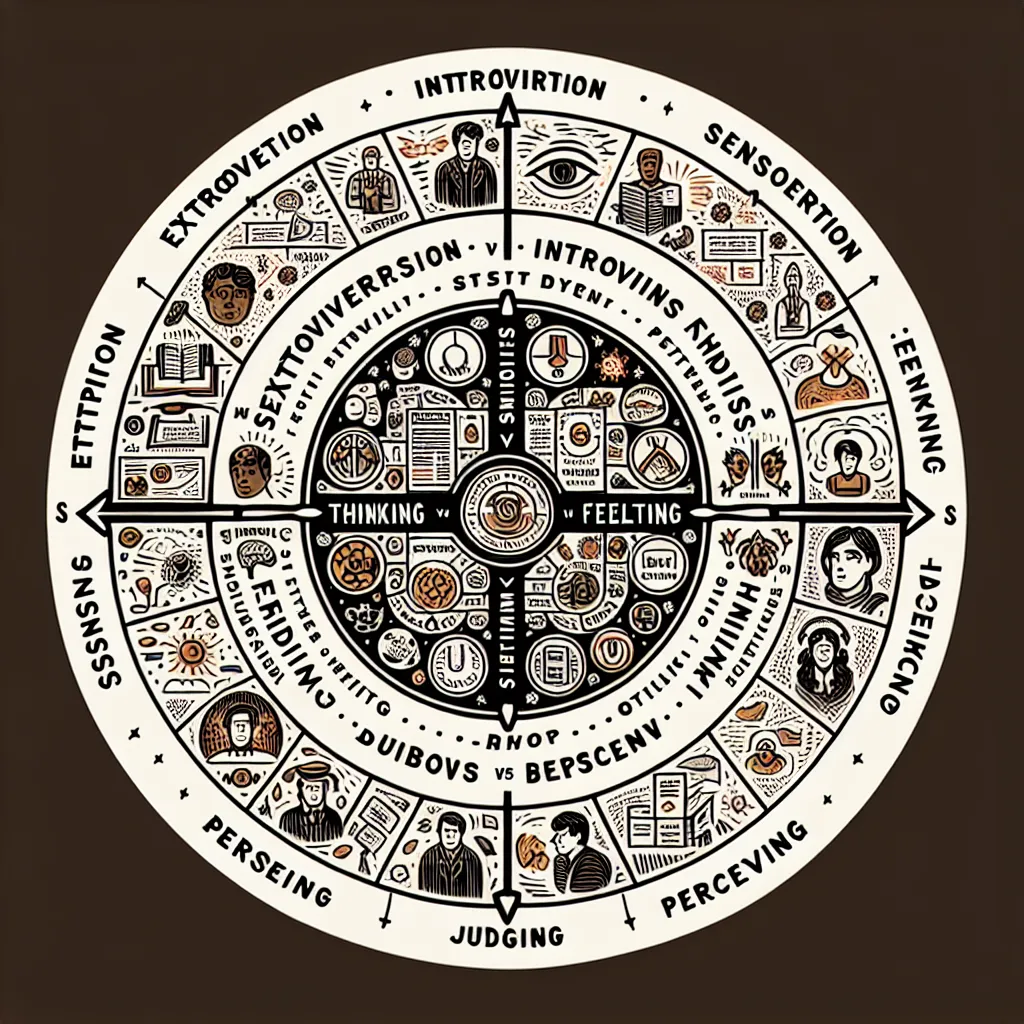Understanding the Myers-Briggs Personality Framework: An Intricate Map of Human Personality
The Myers-Briggs Type Indicator (MBTI) is one of the most renowned and widely used personality assessment tools across the globe. It is based on Carl Jung’s theory of psychological types and was developed by the mother-daughter duo Katherine Briggs and Isabel Briggs Myers. Unraveling the layers of this complex framework provides invaluable insight into the intricacies of human behavior, preferences, and interpersonal dynamics.
At its core, the MBTI is designed to categorize individuals into one of 16 distinct personality types. These personality types are determined by evaluating an individual’s preferences across four dichotomies: Extraversion vs. Introversion (E/I), Sensing vs. Intuition (S/N), Thinking vs. Feeling (T/F), and Judging vs. Perceiving (J/P). Each combination of the four preference pairs results in a unique personality type, encapsulated by an acronym such as INFP or ESTJ.
Extraversion and Introversion explore the direction of one’s energy. Do people recharge by spending time with others (Extraversion), or do they find solace in solitude (Introversion)? This aspect of personality governs how individuals engage with the world around them.
The Sensing/Intuition dichotomy assesses how one gathers information. Sensors focus on the present, relying on concrete facts and tangible data, while Intuitives are drawn to future possibilities, patterns, and meanings beyond the surface level. This dimension affects how individuals process information and form judgments.
When it comes to decision-making, the Thinking/Feeling dichotomy comes into play. Thinkers tend to rely on logical analysis and objective criteria, whereas Feelers prioritize harmony, and the impact decisions will have on others, leading with their personal values and emotions.
Finally, the Judging/Perceiving contrast sheds light on one’s lifestyle approach. Judgers prefer structure, schedules, and organization, aiming for closure and resolution, whereas Perceivers enjoy flexibility, openness, and adapting to new information as it arises.
The Myers-Briggs framework is instrumental for a multitude of purposes, of which career counseling is notably prevalent. It can guide individuals towards professional paths well-suited to their innate preferences, foster team building by helping members understand one another’s working styles, and assist managers in tailoring their leadership methods to the diverse temperaments of their employees.
Personal relationships also benefit from the insights provided by MBTI. Understanding one’s own type, as well as that of others, can facilitate better communication, foster empathy, and minimize conflicts by highlighting the diverse ways in which people perceive the world and make decisions.
Furthermore, the MBTI is a potent tool in the realm of personal development. By identifying areas of strength and potential growth, individuals can embark on a journey of self-improvement. This might involve stretching beyond one’s comfort zone to develop lesser-used cognitive functions, or building upon inherent strengths to achieve greater success and fulfillment.
However, it is crucial to acknowledge that the Myers-Briggs framework is not without criticism. Some researchers debate the validity and reliability of the assessment, pointing to the variability of results over time and the theory’s reliance on binary choices rather than a spectrum of personality traits. Critics also argue that type labels may lead to overgeneralizations and a fixed mindset regarding one’s traits and capabilities.
Despite these criticisms, the MBTI continues to be a popular tool, grounded in its capacity to simplify the complexity of human nature into a digestible and actionable format. It is applied extensively in educational settings, corporate environments, and for individual self-discovery.
To get the most out of the Myers-Briggs framework, individuals and professionals should approach it with a nuanced understanding of its limitations and a recognition that personality is fluid and influenced by a myriad of factors including environment, experiences, and personal growth.
With enhanced self-awareness and an appreciation of the diverse cognitive landscapes that make up the human experience, the Myers-Briggs Type Indicator acts not as a definitive map but as a compass, guiding individuals and organizations toward more harmonious and fruitful interactions.
In the digital age, the dissemination of information regarding the MBTI is further facilitated by online assessments, forums, and social media platforms where like-minded individuals discuss and exchange ideas pertaining to their personality types. The vast resources available online enable a deeper dive into the functionalities of each type, their potential career paths, relationship dynamics, and strategies for personal growth.
Moreover, as workplaces evolve with a growing emphasis on the importance of emotional intelligence and soft skills, the MBTI gains additional relevance. Integrating the framework within team-building exercises and leadership development programs empowers individuals to leverage their personality type for enhanced communication and better management practices.
To navigate the complexities of the human psyche, it is essential for MBTI enthusiasts and skeptics alike to approach the framework critically, recognizing its potential to foster personal insights and improve interpersonal relations while maintaining a practical awareness of its shortcomings.
In the realm of search engine optimization (SEO), the appeal of the Myers-Briggs framework can be leveraged to create engaging online content. By incorporating relevant keywords and phrases such as “MBTI types,” “personality assessment,” and “career counseling,” digital content creators can attract individuals seeking to understand more about the MBTI and its applications.
The ongoing popularity of the Myers-Briggs Type Indicator reflects a universal human quest to understand oneself and others. The framework provides a structured yet flexible approach for exploring personality, respecting the uniqueness of each individual while offering a common language for discussing personal differences.
Professionals and individuals should consider pairing the MBTI with other personality instruments or comprehensive psychological evaluations for a more complete picture of an individual’s psychological makeup. In doing so, the Myers-Briggs framework can become part of a holistic approach to understanding human behavior and fostering a more empathetic and cohesive society.
Ultimately, the Myers-Briggs personality framework stands as a testament to our enduring curiosity about the many facets that compose the human character. Whether used for personal insight, career guidance, or improving social dynamics, this tool reminds us of the rich tapestry of human diversity and the value of embracing our differences as much as celebrating our commonalities. The key to unlocking the full potential of the MBTI lies in applying it with discernment, an open mind, and a willingness to explore the depth and breadth of what it means to be uniquely human.



Leave a Comment